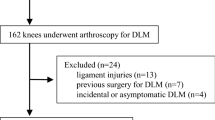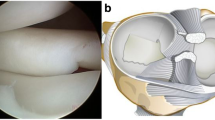Abstract
Introduction
Little is known about peripheral rim instability (PRI) of adult discoid lateral meniscus (DLM). We compared PRI of the intact DLM (iDLM) to those of intact normal lateral meniscus (LM) in adult patients and also investigated whether there was any association between PRI and DLM tears.
Materials and methods
We investigated PRI in 17 DLMs and 60 normal LMs without tears during arthroscopic surgery for medial compartmental pathologies between June 2012 and October 2015. We also investigate PRI of torn DLM (tDLM) excluding peripheral tear to compare the PRI between intact and torn DLM. Stability parameters were measured using a probing hook and arthroscopic ruler at the anterior, middle, and posterior parts of the peripheral rim of the menisci: translating the anterior horn (AH) and mid-body (MB) and lifting the posterior horn (PH).
Results
AH and PH instabilities were greater in the iDLM group than in the iLM group (2.2 ± 1.4 vs. 0.9 ± 1.4 mm, p = 0.006 and 3.4 ± 1.7 vs. 1.7 ± 1.2 mm, p = 0.004, respectively). However, there was no significant difference in MB instability between two groups. In addition, no significant difference was observed in all the parameters between the iDLM and tDLM groups.
Conclusion
Both iDLM and tDLM had greater PRI of the AH and PH than the iLM in adult patients. Thus, the DLM is prone to tear and careful inspection is needed not to overlook PRI of a DLM even if the peripheral attachment is intact.
Level of evidence
Level 3, comparative study of anatomical instability of living subjects.



Similar content being viewed by others
References
Ahn JH, Lee SH, Yoo JC, Lee YS, Ha HC (2008) Arthroscopic partial meniscectomy with repair of the peripheral tear for symptomatic discoid lateral meniscus in children: results of minimum 2 years of follow-up. Arthrosc J Arthrosc Relat Surg 24(8):888–898
Aichroth PM, Patel DV, Marx CL (1991) Congenital discoid lateral meniscus in children. A follow-up study and evolution of management. J Bone Jt Surg Br Vol 73(6):932–936
Atay OA, Pekmezci M, Doral MN, Sargon MF, Ayvaz M, Johnson DL (2007) Discoid meniscus: an ultrastructural study with transmission electron microscopy. Am J Sports Med 35(3):475–478
Bellier G, Dupont JY, Larrain M, Caudron C, Carlioz H (1989) Lateral discoid menisci in children. Arthrosc J Arthrosc Relat Surg 5(1):52–56
Davidson D, Letts M, Glasgow R (2003) Discoid meniscus in children: treatment and outcome. Can J Surg 46(5):350–358
Dickason JM, Del Pizzo W, Blazina ME, Fox JM, Friedman MJ, Snyder SJ (1982) A series of ten discoid medial menisci. Clin Orthop Relat Res 168:75–79
Dimakopoulos P, Patel D (1990) Partial excision of discoid meniscus. Arthroscopic operation of 10 patients. Acta Orthop Scand 61(1):40–41
Elkousy H, Higgins LD (2005) Zone-specific inside-out meniscal repair: technical limitations of repair of posterior horns of medial and lateral menisci. Am J Orthop (Belle Mead, NJ) 34(1):29–34
Good CR, Green DW, Griffith MH, Valen AW, Widmann RF, Rodeo SA (2007) Arthroscopic treatment of symptomatic discoid meniscus in children: classification, technique, and results. Arthroscopy 23(2):157–163
Hagino T, Ochiai S, Senga S et al (2017) Arthroscopic treatment of symptomatic discoid meniscus in children. Arch Orthop Trauma Surg 137(1):89–94
Hamada M, Shino K, Kawano K, Araki Y, Matsui Y, Doi T (1994) Usefulness of magnetic resonance imaging for detecting intrasubstance tear and/or degeneration of lateral discoid meniscus. Arthrosc J Arthrosc Relat Surg 10(6):645–653
Haviv B, Bronak S, Kosashvili Y, Thein R (2016) Arthroscopic meniscectomy of traumatic versus atraumatic tears in middle aged patients: is there a difference? Arch Orthop Trauma Surg 136(9):1297–1301
Hayashi LK, Yamaga H, Ida K, Miura T (1988) Arthroscopic meniscectomy for discoid lateral meniscus in children. J Bone Jt Surg Am Vol 70(10):1495–1500
Kelly BT, Green DW (2002) Discoid lateral meniscus in children. Curr Opin Pediatr 14(1):54–61
Kim SJ, Chun YM, Jeong JH, Ryu SW, Oh KS, Lubis AM (2007) Effects of arthroscopic meniscectomy on the long-term prognosis for the discoid lateral meniscus. Knee Surg Sports Traumatol Arthrosc 15(11):1315–1320
Kim SJ, Kim DW, Min BH (1995) Discoid lateral meniscus associated with anomalous insertion of the medial meniscus. Clin Orthop Relat Res 315:234–237
Klingele KE, Kocher MS, Hresko MT, Gerbino P, Micheli LJ (2004) Discoid lateral meniscus: prevalence of peripheral rim instability. J Pediatr Orthop 24(1):79–82
Lyle NJ, Sampson MA, Barrett DS (2009) MRI of intermittent meniscal dislocation in the knee. Br J Radiol 82(977):374–379
Mutsaerts EL, van Eck CF, van de Graaf VA, Doornberg JN, van den Bekerom MP (2016) Surgical interventions for meniscal tears: a closer look at the evidence. Arch Orthop Trauma Surg 136(3):361–370
Papadopoulos A, Kirkos JM, Kapetanos GA (2009) Histomorphologic study of discoid meniscus. Arthrosc J Arthrosc Relat Surg 25(3):262–268
Smillie I (1970) Injuries to the knee joint, 4th edn. Churchill Livingstone, Edinburgh
Suganuma J, Mochizuki R, Inoue Y, Yamabe E, Ueda Y, Kanauchi T (2012) Magnetic resonance imaging and arthroscopic findings of the popliteomeniscal fascicles with and without recurrent subluxation of the lateral meniscus. Arthrosc J Arthrosc Relat Surg 28(4):507–516
Thompson WO, Thaete FL, Fu FH, Dye SF (1991) Tibial meniscal dynamics using three-dimensional reconstruction of magnetic resonance images. Am J Sports Med 19(3):210–215 (discussion 215–216)
Washington ER III, Root L, Liener UC (1995) Discoid lateral meniscus in children. Long-term follow-up after excision. J Bone Jt Surg Am Vol 77(9):1357–1361
Yoo WJ, Choi IH, Chung CY et al (2008) Discoid lateral meniscus in children: limited knee extension and meniscal instability in the posterior segment. J Pediatr Orthop 28(5):544–548
Young R (1889) The external semilunar cartilage as a complete disc. Mem Memo Anat 1:179
Funding
There is no funding source.
Author information
Authors and Affiliations
Corresponding author
Ethics declarations
Conflict of interest
The authors declare that they have no conflict of interest.
Ethical approval
This article does not contain any studies with human participants or animals performed by any of the authors.
Informed consent
Informed consent was obtained from all individual participants included in the study.
Rights and permissions
About this article
Cite this article
Kim, J.H., Bin, SI., Lee, BS. et al. Does discoid lateral meniscus have inborn peripheral rim instability? Comparison between intact discoid lateral meniscus and normal lateral meniscus. Arch Orthop Trauma Surg 138, 1725–1730 (2018). https://doi.org/10.1007/s00402-018-2987-9
Received:
Published:
Issue Date:
DOI: https://doi.org/10.1007/s00402-018-2987-9




